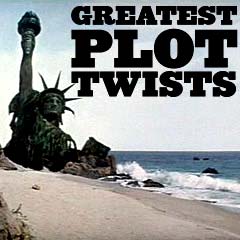
|
Film Spoilers and Surprise Endings M2 |
|
|
||||||
| Film Title/Year and Plot Twist-Spoiler-Surprise Ending Description | ||||||
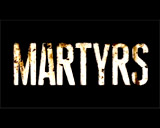
|
Martyrs (2008, Fr/Can.)
Writer/director Pascal Laugier's unrated, gory, nihilistic horror film was accused of being one of the most violent movies ever made - part of a hardcore trend in French films called the "New French Extremism" that portrayed intense pain, hatred and suffering. Its premise was that spiritual transcendence was just beyond the horizon of ultimate pain. The controversial film was similar to the graphic, torture-porn film franchises in the US begun with Saw (2004) and Hostel (2005), although more compelling with greater intellectual significance. When the divisive film debuted at the Cannes Film Festival in 2008, it caused many audience members to walk out. The final 15 minutes of the unpleasant film was considered unflinchingly horrendous in its portrayal of cruelty. The plot was a brutal tale about abducted, abused (although there were no signs of sexual abuse) and badly-battered young 10 year-old Lucie Jurin (Jessie Pham as youth) who - in 1971 - escaped from her chained captivity in a torture room-chamber in an abandoned, unused brick slaughterhouse. Found malnourished, dehydrated, bloody and bruised, half-clothed, filthy, and starving after running down a road, she was hospitalized in pediatric services. She was observed as suffering from "malnutrition, dehydration, mild hypothermia." She was placed in an orphanage, where she developed a close friendship with another abused victim Anna (Erika Scott as youth). Lucie felt haunted and terrorized by an imagined, nightmarish, ghoulish, masochistic pale-skinned Creature (Isabelle Chasse) - a scarred, scrawny, filthy, emaciated, stringy long-haired female who caused mutilations and flesh wounds. Fifteen years later in 1986, 25 year-old Lucie Jurin (Mylène Jampanoï as adult) sought revenge for the individuals who abused a decade and a half ago. She came upon an isolated house and savagely, cold-bloodedly murdered with a shotgun an entire middle-class French family on a Sunday morning - the Belfonds (the two teens: high-school athlete Marie and college-bound Antoine, and Mr. Belfond and his wife Gabrielle). The crazed killer shook the dead bodies of the two adults and asked about her previous torture: "How could you do that to me?" Afterwards, she phoned her friend Anna Assaoui (Morjana Alaoui as adult) and told her that she had vengefully killed who she believed was her tormenting, sadistic captors from years earlier. Abruptly after the murders, Lucie who had apparently gone insane, had another envisioning of the Creature, who remained in the house and wounded Lucie.
She was first slashed and hacked at with a sharp-edged razor on her back and left wrist. Anna arrived at the house, stitched her up, and then Lucie helped her clean up the murder scene. They dragged the four bloody corpses to the bathroom before Anna dumped them into a muddy pit-hole outside. The Creature attacked a second time, seemingly unappeased by the slaughter. Meanwhile, Anna realized that Gabrielle Belfond was still alive, and tried to keep it a secret from Lucie and help her escape. But Lucie found them and mercilessly smashed in Gabrielle's head with a hammer. The Creature returned and the suicidal Lucie felt that she would never find rest from her torment and insanity. She slit her own arms with a razor blade, jumped through a glass window, and remorsefully ripped open her own throat with a box-cutter - giving her peace when she died in Anna's arms in the pouring rain. Melancholy about the death, Anna remained in the home through the next day. A number of twists and surprises occurred in the film from this half-way point forward:
The members of the secret society were summoned to the house to learn of Anna's "authentic martyrdom" on the previous day. Anna was praised as being only the 4th individual in 17 years to have attained the stage of martyrdom, and the first to relate what she had seen. She had experienced a state of ecstasy lasting 2 hours and 15 minutes. Although still alive, she was now no longer communicating. Just before revealing Anna's insightful testimony - what Anna had whispered about the afterlife (what "lay beyond death") - Mademoiselle spoke to her assistant Etienne (Jean-Marie Moncelet) and claimed that Anna's words were "very clear" and "precise" with "no room for interpretation." Mademoiselle attempted to speak about the indescribable, the unspeakable horror of what came after death:
The film ended abruptly, with the definition of "martyr" - "noun, from the Greek 'marturos': witness" |
 Abused, Tortured 10 year-old Lucie (Jessie Pham) 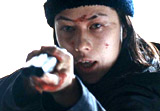 25 year-old Lucie Jurin (Mylène Jampanoï) Murdering Abusive Belfond Family  The Creature (Isabelle Chasse)  The Real Tortured 'Creature': Sarah Dutreuil  Anna Assaoui (Morjana Alaoui)  Anna Giving The Tortured Woman a Bath  Tortured Woman With Removed Metal Blindfold  Mademoiselle (Catherine Bégin) 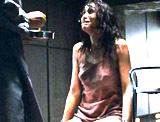    Anna's Martyrdom and Torture, Including Skinning  Anna Whispering To Mademoiselle  Mademoiselle Committing Suicide |
||||

|
Match Point (2005)
Famed writer/director Woody Allen's first R-rated dramatic-erotic thriller, and his first film set and shot in England. The film, without Allen's typical humor, recalled elements of A Place in the Sun (1951), Body Heat (1981), Fatal Attraction (1987), Allen's own Crimes and Misdemeanors (1989), his future film Cassandra's Dream (2007), and similarities to Dostoyevsky's Crime and Punishment 1866 novel. Its main tagline was: "Passion, Temptation, Obsession." The film began with a voice-over narration, a metaphoric musing about chance, luck and fate - it was presented with a side view of a tennis net and the freeze-frame shot of a tennis ball suspended in space over the net - poised to fall on one side or the other:
Chris Wilton (Jonathan Rhys-Meyers) was a handsome, recently-retired Irish tennis pro from a poor background, and an instructor at an exclusive London tennis club. He kick-started a privileged life when he began dating Chloe Hewett (Emily Mortimer), the shy, sweet brunette heiress daughter of Eleanor (Penelope Wilton) and Alec Hewlett (Brian Cox). Soon after, Chris was appointed as an office-worker in the company of her father, as part of a preparatory "grooming" process. While with Chloe and becoming acquainted with her wealthy family, Chris met Nola Rice (Scarlett Johansson), a struggling, chain-smoking, blonde and sexy femme fatale American actress from Boulder, Colorado. She was the girlfriend/fiancee of Chloe's younger brother Tom Hewett (Matthew Goode). Although he was about to marry into the wealthy Hewett family, he was smitten with Nola. The first steamy, clandestine tryst between Nola and Chris occurred shortly after another of Nola's failed auditions. They both met up in a wheat-field near the Hewlett country estate during a rainstorm, and made love. The affair with Nola ended after Tom admitted that he had broken up with Nola (Tom: "I've met someone else"). Nola was forced to return to the US to look for a job. Although Chris was now a married man, he became obsessed with Nola when she returned to London - and they continued their discreet affair. When Nola, ironically, became pregnant, she adamantly refused to get an abortion, and she threatened to reveal everything to Chloe. Chris contemplated murder as a way out of his guilt-ridden, adulterous dilemma. With a shotgun (broken down and hidden in his tennis bag), Chris killed (off-screen) Nola's next-door apartment neighbor Mrs. Betty Eastby (Margaret Tyzack), then staged a burglary in her apartment. He also shot and killed Nola (off-screen) when she stepped off the elevator after returning from work. Scotland Yard considered Chris a suspect since he was often mentioned in Nola's diary. He denied being a murderer, although he did admit to being an adulterer.
Luckily for Chris, the gold ring (that he had discarded from the burglary into a river - and coincidentally fell back onto a sidewalk) was picked up by a known drug dealer-addict (a junkie who was later found murdered) and the drug-related burglary-crime was pinned on him:
The case against Chris was closed - he was guilty of adultery, but not murder ("He's another poor schmuck who cheated on his wife"). Meanwhile, Chloe's baby boy was born - and her father Alec joyously toasted the boy: "With parents like Chloe and Chris, this child will be great at anything he sets his mind to." Tom retorted: "I don't care if he's great. I just hope that he's lucky." The final shot of the film saw Chris troubled, standing apart and very disconnected from his happy family. |
 Chris Wilton (Jonathan Rhys-Meyers)  Chris With Nola Rice (Scarlett Johansson)   Chris and Nola Having Sex  Chris With Shotgun, Killing Nola's Neighbor to Stage a Burglary  Chris Murdering Nola  Final Image of a Troubled Chris |
||||

|
Matchstick Men (2003)
Director Ridley Scott's crime drama was about two professional, small-time LA con-men, who were swindlers selling cheap water-filtration systems and filters - with bogus prizes:
Roy's schemes were threatened because of his obsessive-compulsive traits, neurosis and panic attacks, growing mental illness and depression, and agoraphobia. During psychoanalysis with a new psychiatrist, Dr. Harris Klein (Bruce Altman), Roy learned that he had a long-lost, 14 year-old teenaged "daughter," now Angela (24 year-old Alison Lohman). He thought she was conceived before he split 14 years earlier from his ex-wife Heather (Melora Walters).
After Roy met pig-tailed Angela at an outdoor park, he took her to get something to eat, when she thought he was an ex-con, but then forgave him: "lt's okay, you know. Whatever you do. Everybody's done something bad in their life." She had an excuse to move in with Roy for one weekend, during which time she prophetically told him: "I'm not as innocent as you think, Roy. I've done stuff with boys. I've done stuff with boys if I told you, you'd probably throw up right here." After an elaborate scheme that bilked Roy out of his own money (stashed in a plastic doggie bank in his living room), he learned that blonde Angela was part of the scam (to trick him into believing she was his daughter). Angela was part of the con to have him trust in her, so that the cons could completely fool Roy and steal all of his money. The scam involved at least three others, including:
In the surprising conclusion one year later, the ultimate 'con' of sorts, it was revealed that the betrayed Roy was working a legitimate job as a rug salesman and that he had turned his back on crime and con-games. He was virtually cured of his extreme obsessive-compulsive disorders. He happened to meet an apologetic, dark-haired Angela in his store with her slacker boyfriend purchasing a rug. Roy didn't mention her previous scams in the presence of her boyfriend, although Angela claimed that she had "retired...that was a one-time deal," but she complimented him for being a great scam-teacher. He added: "l'm kinda surprised to see you here. l figured you would have moved out to, uh, l don't know, Hawaii." She replied: "l kind of got screwed on my cut. You know Frank" - something he said was not unusual in the con business: "You're gonna go swimming, you're gonna get wet, right?" (using a phrase she had spoken before). Then, he complimented her: "You changed your hair. Makes you look grown-up," and then she abruptly apologized: "l'm sorry too, if it's any consolation. You mad at me?" He then forgave her:
As she left, she called him: 'Dad.' Then it was revealed what Roy's new life was like. After buying groceries, he drove home, where his slowly-developing love interest had been fulfilled with long-haired brunette Kathy (Sheila Kelley) - the observant cashier at the supermarket throughout the film (from whom he bought canned tuna, cigarettes, and ice cream). She was his new and pregnant wife - he kissed her and listened to her pregnant belly, to the tune of Frank Sinatra's "Summer Wind." |
  Roy Waller (Nicolas Cage)   14 year-old Angela (Alison Lohman)    Angela at the Rug Store One Year Later - An Apology to Roy   Roy's New and Pregnant Wife Kathy (Sheila Kelley) |
||||
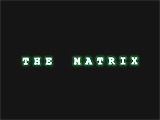
|
The main character in Andy and Lana Wachowski's dystopian, action-adventure sci-fi film, the first in a franchise of three films, was an individual who was living two lives:
He was eventually contacted by two individuals, who told him about the "Matrix" - and how the real world was only artificial and illusory - and actually a ravaged wasteland with subdued human beings:
Neo chose to take a red pill from Morpheus, after which he went down the "rabbit hole" - essentially, he learned that the Matrix was a fabricated, illusory dream world created by an intelligent, mechanized and artificial life form. The race of machines was using enslaved, but unaware humans as its power source for heat and electricity. Trapped humans were grown in liquid-filled pods and connected to the Matrix with cybernetic cables and implants, to provide the machines with an energy source. Morpheus and other rebels "unplugged" enslaved humans and recruited them as rebels. According to the Matrix's premise, the world was really a virtual reality computer program that actually existed in the 22nd century. Neo was informed that only a small number of freed, rebellious humans (Morpheus, Trinity, Switch, etc.) really lived in the real world - in an underground city and refuge called Zion. As a rebel against the machines, Neo was compelled to return into the Matrix and confront the agents - super-powerful computer programs who were intent on eliminating Neo and the entire human rebellion against them, and whose main objective was to keep humans entrapped in the Matrix. The Messianic figure Neo (the "One") was called upon to save and liberate humanity from indestructible government agents - powerful sentient software programs, such as villainous, sinister, black-suited lead Agent Smith (Hugo Weaving), by hacking into the Matrix, 'unplugging' other humans, and recruiting them for further resistance. Neo learned the true nature of the simulated reality - and was able to have control over the Matrix. In doing so, he was able to dodge bullets (with slow-motion "bullet time"), bend the laws of physics, and attain superhuman powers. He was able to perform impossible feats of physicality (such as running up walls or leaping impossibly high) and alter his perception so dramatically that he saw bullets in flight in order to dodge them. The Oracle (Gloria Foster), however, told him about how he might not be the One - the prophesied, gifted individual who would lead the insurrection of enslaved humans against the machines:
Many of the crew members of the Morpheus's hovercraft Nebuchadnezzar in the real-world were killed (Dozer, Apoc, and Switch) when disillusioned Cypher (Joe Pantoliano) betrayed the group to Agent Smith. Soon after, however, the traitor was killed by wounded crew member Tank (Marcus Chong). Neo was shot dead by Agent Smith (within the Matrix) during an ambush, but a kiss from Trinity's lips revived and reawakened him. Neo stood up, raised his arm, and the palm of his hand resisted more of the agents' bullets in mid-air. As the One, he finally understood that the bullets fired against him were not real. He saw the Matrix as it really was - it was solely lines of downward-streaming green and white computer code (or 'digital rain'). He realized that he was actually the One, left to singlehandedly conquer, vanquish, and literally destroy Agent Smith in the film's conclusion. Neo thwarted Agent Smith's goal to stop him from getting out of the Matrix. As Neo was revived, menacing "Sentinel" machines were attacking and threatening the hovercraft, but Neo was able to leave the Matrix just in time before the Sentinels were disabled by the ship's electromagnetic pulse weapon. The Matrix could now be controlled. In the final scene within the green-tinged Matrix before Neo flew away into the sky, he made an ominous telephone call from a phone booth to the machine masters who were imprisoning humans - he threatened to expose them and create a new world:
|
  Morpheus' Pill Choice   Humans Enslaved in Pods 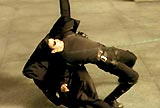 "Bullet-Time"  Neo Shot Dead by Agent Smith  Trinity's Kiss  Resisting Bullets  The Matrix: Green Lines of Code   Destruction of Agent Smith (Hugo Weaving)    Neo's Threatening Phone Call  Neo Flying Away |
||||

|
Meet Joe Black (1998)
Director Martin Brest's tedious, manipulative and overly-long, dramatic romance-fantasy film (loosely based on Death Takes A Holiday (1934)) began with an introduction of the main characters, including:
However, his life was short-lived. In the middle of the street as he turned to look back at Susan after she disappeared around a building, the lawyer was violently killed in a car accident when he was struck by one van and then his body was tossed in the air into a taxi-cab. Parrish was given a negotiated reprieve of time from death by the voice of Death for an undetermined amount of time during an appearance to him in his home's library. Parrish was complimented for his frequent dispensation of wisdom about love and life, and was chosen to be Death's personal 'guide.' Death struck a deal with the dying Bill Parrish, who was suffering from a bad heart, because Death wanted to see what it was like to be mortal:
The lawyer's body then reappeared - to join the dinner in progress. The dead lawyer's body was taken over by an inarticulate, often silent personification of the Angel of Death (also Pitt), and taking the name of "Joe Black." Parrish was to introduce Joe Black to new things and experiences in earthly life, including the love of his daughter Susan.
Parrish's beloved daughter fell in love with the passionless, metaphysical doppelgänger "Joe Black" in a doomed relationship. By the end of the film, there was a strong mutual love between "Joe Black" and Susan. When Joe revealed his true identity to Susan and she expressed distress, he abandoned his plan to take her away, and decided to let her live her own earthly life. Joe also exposed dishonest business associate Drew as an undercover IRS agent trying to sabotage Parrish's company by creating an "undisclosed conflict of interest...an indictable offense." Drew was offered a deal to avoid jail time - he must confess to the board every detail of his participation, and then submit his resignation. Parrish was reaffirmed as the chairman of the board of Parrish Communications, and the merger with Bontecou International was rejected. The film ended with a tear-jerking, fireworks-filled conclusion, set at Bill's 65th birthday party celebration. Parrish delivered a heart-warming speech to everyone:
And then after one last dance with his daughter and a hug, Parrish met up with Joe Black, his afterlife escort. Parrish expressed his gratitude to Joe for what he had done for Susan. The two walked over a bridge into death on the horizon. Joe gave Susan a second chance at love by restoring his body to its previous mortal owner, the coffee shop lawyer, and coming back to her across the bridge. She knew nothing of their previous encounters when he represented Death. They spoke a few words to each other, and then arm in arm, watched the fireworks show celebrating her father's birthday:
|
 Susan Parrish (Claire Forlani)  Lawyer in Coffee Shop (Brad Pitt)  Bill Parrish's (Anthony Hopkins) Bad Heart  Death of Lawyer in Street  Death's Appearance to Parrish in His Library  The First View of Death - aka "Joe Black" (Brad Pitt)  Parrish's 65th Birthday Party Speech  Last Dance with Daughter  To the Afterlife    The Return of the Lawyer to Susan |
||||

|
Memento (2000)
This thought-provoking, unique and puzzling thriller from director Christopher Nolan had the tagline:
With its enigmatic story told in reverse, it was challenging in itself just to watch due to its non-linear, backwards narrative structure. A crucial fact about the smoothly-edited film was:
Both narratives played separately and alternately until the film's climactic conclusion when the two strands merged into a color sequence - at the time of the strangulation of Jimmy Grantz. The main protagonist was suffering from anterograde amnesia (with no short-term memory), and was unable to create new memories: Leonard Shelby (Guy Pearce), an ex-insurance investigator. He was first seen in an "anonymous room" at the Discount Inn (actually because of his short-term memory loss issues, he was ripped off and tricked into renting two rooms, # 21 and # 304). He told a little about his situation, in voice-over, and talked on the phone. He described what he was investigating - the allegedly brutal and cold-blooded rape and murder of his wife (Jorja Fox). She had been strangled after being wrapped in a shower curtain by a masked intruder. There were two murderous burglars involved in the violent incident - Leonard shot and killed one of them, but the second individual (before fleeing) threw him into a mirror, where he suffered a severe blow to the head. He fell unconscious to the bathroom floor next to his wife. The police didn't believe there was a second individual, according to the evidence at the crime scene. In the film's first scene (although it was located at the end of the story due to its reversed order), Leonard killed his confidante/associate: "Teddy" Gammell (Joe Pantoliano), a crooked SF undercover cop whose real name was John Edward Gammel (John G). Leonard inaccurately believed that "Teddy" was the second murderous rapist-burglar of his wife, but as it turned out, "Teddy" was the 'wrong guy' and wasn't responsible for his wife's death at all. And Leonard's wife had actually survived the rape attack! "Teddy" had been assigned to the case of the rape of Leonard's wife, and sympathized with the memory-damaged Leonard: "I thought you deserved a chance for revenge." All along, Teddy knew the truth about the case, but believed he could help Leonard by restoring some meaning to his life rather than having him face his own guilt. The real assailant was named John G, who was executed by Leonard a year earlier: "We found him. You killed him" - but Leonard had forgotten. "Teddy" reminded Leonard:
Amnesia resulted from the blow to his skull, forcing Leonard to use self-inflicted tattoos, Polaroid snapshots, and cryptic notes to aid his short-term memory and provide clues that he used in his investigation:
And as the film unfolded, it was revealed that Leonard had, ironically, remembered only some elements about his wife's condition (she didn't suffer a traumatic death due to the rape incident), but only as a projection onto:
Sammy was a married, 58 year-old semi-retired accountant who also had an accident (a car crash) that caused anterograde amnesia (short-term memory loss). Leonard exposed him as a fraud during his investigation into Sammy's mental condition. Leonard thought that Sammy had faked suffering from memory loss. Leonard harshly denied Sammy's accident insurance claim, arguing it was a psychological (mental), not a physical problem - then, the insurance company ruled that Sammy wasn't covered for mental illness. Leonard told a revealing but semi-confused story (intermixed with facts about his own life with his wife) about Sammy (whose name was tattooed in cursive writing on his left hand as "Remember Sammy Jankis"). Leonard recounted that Sammy suffered from apparent memory loss (like he did), and had accidentally killed his diabetic wife with an overdose of insulin. The wife was testing his memory, by repeatedly asking him to administer her insulin shots - and he dutifully gave her dose after dose after dose - until she died. This led clearly to suspicions that Sammy's story was actually Leonard's story (Leonard: "I could have done something like Sammy"). Leonard had projected his own life, and his accidental killing of his own wife, onto Sammy. However, Leonard denied that his wife was diabetic ("My wife wasn't diabetic") - because if she had been, then it would have opened up the possibility that he had killed her with extra doses of insulin. Leonard insisted that the insulin death of Sammy's wife wasn't related to him: "That's Sammy, not me...Sammy let his wife kill herself. Sammy ended up in an institution." But "Teddy" reminded him --
Most importantly, Sammy NEVER really existed as remembered by Leonard.
Leonard, in parallel fashion, had killed his own wife - she had expired from a diabetic coma from an insulin overdose. Leonard's wife, who didn't believe his loss-of-memory condition, had tested his short-term memory loss by demanding a succession of shots of insulin. He forgetfully complied, and provided her with too many insulin shots and she overdosed from the extra shots, which sent her into a coma and killed her. Facts in the film revealed this about Leonard's repeating revenge - he was blindly avenging an act that had already been avenged:
As the film ended, Leonard knew that he couldn't remember what "Teddy" was telling him, about how he would continue his guilt-ridden vengeful mission to search for a killer. So Leonard did the following things to set up "Teddy" as his next suspect, although "Teddy" was innocent - he was NOT the second attacker of Leonard's wife:
|
 Tattooed Leonard (Guy Pearce)   The Rape-Murder of Leonard's Wife, and Leonard's Head Injury  Polaroid Taken Just After Leonard Killed John G, a Year Earlier  "Teddy" (Officer John Gammel)  "Remember Sammy Jankis" 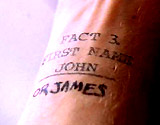 Clues    The License Plate  Repeated Insulin Injections that Killed Sammy's 'Wife' 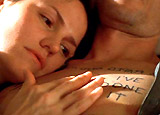 "I've Done It" Tattooed On Leonard's Heart 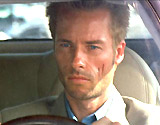  Teddy's Murder by Leonard |
||||
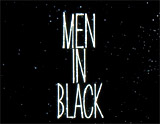
|
Men in Black (1997)
The Men in Black of the film's title originally referred to a sci-fi comic book series, first published in 1991, about a top-secret organization of agents that monitored, regulated and policed paranormal and alien activity on Earth. There were two film sequels to the 1997 release, in 2002 and 2012. In all three science-fiction comedies, there were two starring MIB agents, named after their black suits, shoes, ties, and sunglasses. In this first of the series from director Barry Sonnenfeld, J (with his memory and his life as a private citizen entirely erased) had been recently recruited to join older partner K:
Their task was to save the Earth from destruction by inter-galactic terrorist forces. Extraterrestrial lifeforms were living on Earth and hiding their existence from ordinary humans. When the MIB agents terminated an alien, they used a Neuralyzer (in the shape of a cigar tube) to wipe the memories of witnesses and other humans, to ostensibly protect them and hide the existence of extra-terrestrial alien life-forms from human knowledge. A bright red flash from the device would wipe the memories of the past hours, days, weeks, months or years, depending on the settings. The two MIB agents wore sunglasses to reflect the neuralyzer rays so they wouldn't be affected. In their investigations in Manhattan (where most aliens were hiding) to protect humans from the "scum of the universe," they discovered the makings of an inter-galactic war between rival extra-terrestrial aliens.
One of the galactic rival insectoids had taken over and was concealed inside the body of innocent country bumpkin Edgar (Vincent D'Onofrio) - thus Edgar Bug. At the morgue with deputy medical examiner Dr. Laurel Weaver (Linda Fiorentino), the two agents examined the head of one of the bodies that was killed by the alien "Bug." There, they found a dying, human-looking Arquillian alien, named Gentle Rosenberg (Mike Nussbaum). Gentle Rosenberg was actually an exiled member of an alien royal family. Before dying, Rosenberg revealed the location of the much sought-after miniature galaxy (a massive source of energy) - it was concealed in the neck 'belt' or collar of Rosenberg's cat named Orion:
The stolen galaxy and the death of Rosenberg sparked the warfare. An ultimatum to the MIB agents gave them only one hour to acquire and return the galaxy to the Arquillians, or Earth would be destroyed. The miniature galaxy was seized by Edgar, Dr. Weaver was kidnapped from the morgue, and Edgar flew off in a flying saucer. After the spacecraft was shot down by the two agents, the evil alien bug revealed itself when it peeled away the Edgar shell. When the "Bug" was finally destroyed with the help of coroner Dr. Weaver (after both agents were covered with slime from the belly of the creature after K was expelled), the galaxy was recovered. K revealed he was not training J as a partner, but as a replacement after he retired:
There was a sweet, heartfelt conclusion - K instructed J how to use the amnesia-creating Neuralyzer to erase his memory:
Before J could protest, K told him in a tortured voice:
After Agent K was zapped and neuralized (with an erased memory), he lived happily ever-after reunited with his wife, and he appeared on the cover of the National Enquirer (in a lead story about having awakened from a 35-year coma). The cover photo showed K standing with his wife while giving her flowers. And now, Dr. Weaver was Agent J's replacement partner Agent L, wearing the all-black uniform. The film famously ended with a bizarre non-sequitur pull-back (or zoom-out) sequence - starting in Manhattan, then pulling back to the Earth and the Moon, then the Solar System and the vast Milky Way galaxy. Everything was shown to be inside a spherical marble (representing a galaxy). The marble was a play toy that was being used in a game with other marbles (or galaxies). The tentacled hand of a green alien picked up the marbles, and dropped them into a collection bag of many marble-galaxies. |
 James Edwards (Will Smith) Before Becoming Agent J  MIB Agents: K and J  Dr. Laurel Weaver (Linda Fiorentino)  The Neuralyzer  Orion's Belt (Collar) Holding a Miniature Galaxy  Edgar Bug (Vincent D'Onofrio)   The Aggressive Inter-Galactic Alien Insectoid ("Bug")  The Recovered Galaxy - in Alien Belly Slime  National Enquirer Headline After K's Retirement   The Zoom-Out Shot and the Alien's Bag of Marble-Galaxies |
||||